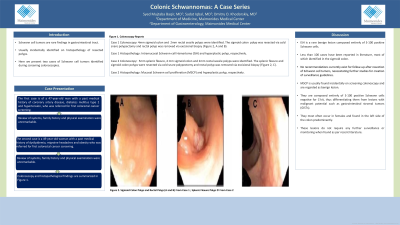Sunday Poster Session
Category: Colon
P0313 - Colonic Schwannomas: A Case Series
Sunday, October 27, 2024
3:30 PM - 7:00 PM ET
Location: Exhibit Hall E

Has Audio

Syed Mujtaba Baqir, MD
Maimonides Medical Center
Brooklyn, NY
Presenting Author(s)
Syed Mujtaba Baqir, MD1, Sadat Iqbal, MD2, Dmitriy O. Khodorskiy, MD3
1Maimonides Medical Center, Brooklyn, NY; 2Maimonides Medical Center, New Hyde Park, NY; 3TriBorough GI, Brooklyn, NY
Introduction: Schwann cell tumors are rare findings in gastrointestinal tract, usually incidentally identified on histopathology of resected polyps. Here we present two cases of Schwann cell tumors identified during screening colonoscopies.
Case Description/Methods: The first case is of a forty-seven-year-old man with a past medical history of coronary artery disease, diabetes mellitus type 2 and hypertension who was referred by his primary care physician for colonoscopy for first colorectal cancer screening. Patient denied family history of inflammatory bowel disease or colon cancer. Review of systems was unrevealing and physical exam was unremarkable. During colonoscopy, a four-millimeter sigmoid colon and a two-millimeter rectal sessile polyps were identified. The sigmoid colon polyp was resected via cold snare polypectomy and rectal polyp was removed via excisional biopsy, with histopathology returning as Intramucosal Schwann-cell Hamartoma (ICSH) and hyperplastic polyp, respectively. The second case is of a forty-nine-year-old woman with a past medical history of dyslipidemia, migraine headaches and obesity who was also referred by her primary care physician for colonoscopy for first colorectal cancer screening. Patient denied family history of inflammatory bowel disease or colon cancer. Review of systems was unrevealing and physical exam was unremarkable. During colonoscopy, a five-millimeter splenic flexure, four-millimeter sigmoid colon and two-millimeter rectal sessile polyps were identified. The splenic flexure and sigmoid colon polyps were resected via cold snare polypectomy and rectal polyp was removed via excisional biopsy, with histopathology returning as Mucosal Schwann Cell Proliferation (MSCP) and hyperplastic polyp, respectively.
Discussion: Schwann cell tumors are usually identified incidentally during colonoscopy and are regarded as benign lesions. They are composed entirely of S-100 positive Schwann cells negative for C-kit, thus differentiating them from lesions with malignant potential such as gastrointestinal stromal tumors (GISTs). Less than 100 cases have been reported in literature, most of which identified in women with left-sided predominance. No recommendations currently exist for follow up after resection of Schwann cell tumors, necessitating further studies for creation of surveillance guidelines.

Disclosures:
Syed Mujtaba Baqir, MD1, Sadat Iqbal, MD2, Dmitriy O. Khodorskiy, MD3. P0313 - Colonic Schwannomas: A Case Series, ACG 2024 Annual Scientific Meeting Abstracts. Philadelphia, PA: American College of Gastroenterology.
1Maimonides Medical Center, Brooklyn, NY; 2Maimonides Medical Center, New Hyde Park, NY; 3TriBorough GI, Brooklyn, NY
Introduction: Schwann cell tumors are rare findings in gastrointestinal tract, usually incidentally identified on histopathology of resected polyps. Here we present two cases of Schwann cell tumors identified during screening colonoscopies.
Case Description/Methods: The first case is of a forty-seven-year-old man with a past medical history of coronary artery disease, diabetes mellitus type 2 and hypertension who was referred by his primary care physician for colonoscopy for first colorectal cancer screening. Patient denied family history of inflammatory bowel disease or colon cancer. Review of systems was unrevealing and physical exam was unremarkable. During colonoscopy, a four-millimeter sigmoid colon and a two-millimeter rectal sessile polyps were identified. The sigmoid colon polyp was resected via cold snare polypectomy and rectal polyp was removed via excisional biopsy, with histopathology returning as Intramucosal Schwann-cell Hamartoma (ICSH) and hyperplastic polyp, respectively. The second case is of a forty-nine-year-old woman with a past medical history of dyslipidemia, migraine headaches and obesity who was also referred by her primary care physician for colonoscopy for first colorectal cancer screening. Patient denied family history of inflammatory bowel disease or colon cancer. Review of systems was unrevealing and physical exam was unremarkable. During colonoscopy, a five-millimeter splenic flexure, four-millimeter sigmoid colon and two-millimeter rectal sessile polyps were identified. The splenic flexure and sigmoid colon polyps were resected via cold snare polypectomy and rectal polyp was removed via excisional biopsy, with histopathology returning as Mucosal Schwann Cell Proliferation (MSCP) and hyperplastic polyp, respectively.
Discussion: Schwann cell tumors are usually identified incidentally during colonoscopy and are regarded as benign lesions. They are composed entirely of S-100 positive Schwann cells negative for C-kit, thus differentiating them from lesions with malignant potential such as gastrointestinal stromal tumors (GISTs). Less than 100 cases have been reported in literature, most of which identified in women with left-sided predominance. No recommendations currently exist for follow up after resection of Schwann cell tumors, necessitating further studies for creation of surveillance guidelines.

Figure: Sigmoid colon polyp and rectal polyp (A and B)
Splenic flexure polyp (C)
Splenic flexure polyp (C)
Disclosures:
Syed Mujtaba Baqir indicated no relevant financial relationships.
Sadat Iqbal indicated no relevant financial relationships.
Dmitriy Khodorskiy indicated no relevant financial relationships.
Syed Mujtaba Baqir, MD1, Sadat Iqbal, MD2, Dmitriy O. Khodorskiy, MD3. P0313 - Colonic Schwannomas: A Case Series, ACG 2024 Annual Scientific Meeting Abstracts. Philadelphia, PA: American College of Gastroenterology.
